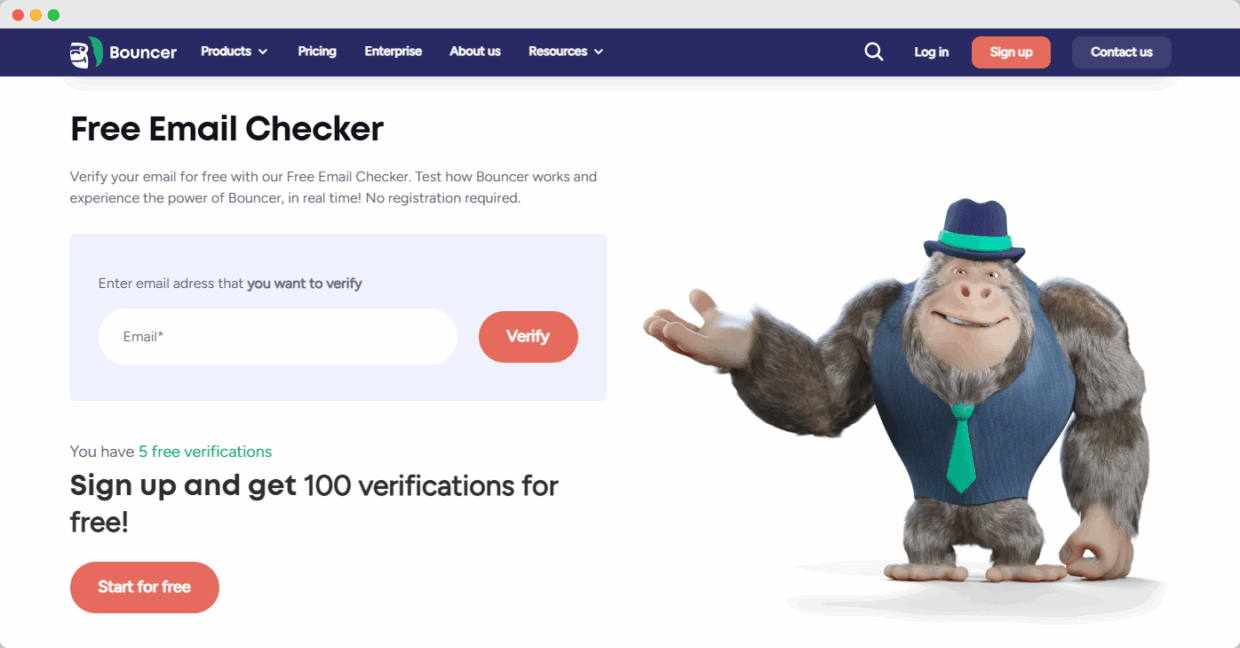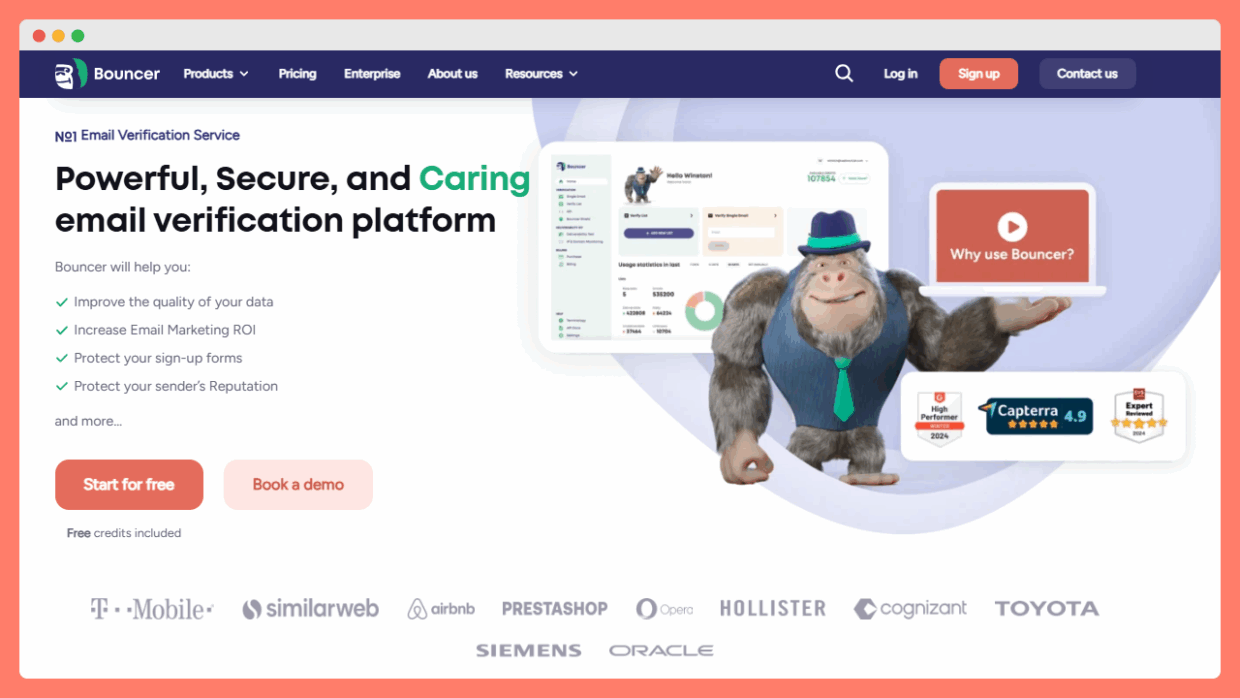For businesses running email campaigns or marketers managing mailing lists, sending to invalid addresses isn’t just a wasted effort—it hurts your sender reputation and tanks your email deliverability.
With high bounce rates (both hard bounces and soft bounces), your emails can land in the dreaded spam folder, even for valid contacts.
So, how to check if email exists without sending a risky test mail?
Whether you’re sending multiple emails for marketing campaigns or just one important message, verifying that an email address is valid saves time and protects your reputation.
Let’s break down exactly how to verify email addresses efficiently and why the right email validation service (like Bouncer) can make the process seamless.
Why it’s critical to check if an email address exists
Sending e mails to non existent emails is more than an inconvenience—it’s a direct hit to your email marketing results. Here’s why verifying email addresses is essential for businesses and anyone who relies on email:
1. Protect your sender reputation
Every invalid address you hit damages your sender reputation—the score email service providers use to decide if your email message lands in an inbox or gets filtered to spam. A high bounce rate, especially hard bounces, is a red flag that tells email servers you’re not cleaning your contact list.
Pro tip: A valid email is the ticket to the inbox. Always validate your email list before sending.
2. Improve email deliverability
Email deliverability is your superpower. Without it, even the best-crafted marketing campaigns will fail. Cleaning out risky emails, like disposable email addresses or spam traps, keeps your list healthy. Verified email addresses mean more messages delivered successfully.
3. Save time and resources
Checking email addresses manually? Forget it. Using a free email checker or email verifier like Bouncer does the heavy lifting in a few seconds. Bulk verification cleans your mailing lists fast, freeing up your time for strategy, not maintenance.

4. Avoid spam complaints and risky emails
Sending to fake emails or outdated addresses can trigger spam complaints or land you in spam traps. These traps are set up to catch spammers, and even legit senders can get caught if they’re not verifying their email list regularly.
Good news: Tools like Bouncer filter out invalid addresses, catch all domains, and disposable email addresses—all without sending a single message.
5. Boost engagement and conversions
Want accurate results from your email campaigns? Start with a clean email list. Verified email addresses mean your messages reach real people, boosting user engagement, clicks, and conversions. Email verification helps you focus on valid users, not dead ends.
Five ways to check if an email exists (without sending a message)
Not all verification methods are created equal. Some are quick fixes, others offer more accurate results for large email lists. Here are five practical ways to check if an email exists before you hit send:
1. Use an email verification tool (the smart way)
If you need email verification service at scale, a tool like Bouncer is the best email checker for the job. It’s designed to validate email addresses quickly and efficiently without clogging your email servers.

Bouncer performs several layered checks:
- Verifies email address format (valid format, syntax check)
- Confirms email’s domain has MX records set up (aka, can the mail server receive emails?)
- Checks the SMTP server for mailbox existence (without sending an email message)
- Filters out disposable email addresses, catch all domains, and spam traps
The beauty? This process takes a few seconds even for multiple emails and keeps your sender reputation intact. Plus, it has a user friendly dashboard and integrates with tools like Google Sheets.
Bouncer even offers a free email list sampling (you can just copy and paste an email and see what happens).
2. Do a manual domain check (MX records lookup)
You can manually verify if the email’s domain is configured to accept emails. This involves checking its MX records (Mail Exchange records)—basically, the mail servers responsible for handling email messages.
- Use other tools like MXToolbox or command-line utilities to see if the domain has active mail servers.
- No MX records? That email address won’t receive emails.
Caveat: This tells you if the domain is valid, not if the email account itself exists.
3. Use a password recovery option (on major platforms)
Want to check if an email address exists on platforms like Google, Yahoo, or others? Use the password recovery feature.
- Enter the email address during account recovery.
- If the platform recognizes it, the email address exists.
This works well for gmail, yahoo, or similar email providers, but it’s not scalable for multiple emails.
4. Search for the email online
A quick Google search of the email address might uncover its presence on websites, forums, or social media. If someone has publicly listed their email account, this can confirm its existence.
- Use quotation marks (“example@email.com”) for exact matches.
- Check sign up forms, business directories, or marketing campaigns that may have the email address listed.
This won’t always work but can be helpful for corporate email addresses or professional email addresses.
5. Try sending an email (carefully)
Sending a polite email message and waiting for a response or bounce can work—but it’s risky. Too many bounces can damage your sender reputation, especially in cold outreach campaigns.
Best for: One-off checks where other methods fail.
Why an email validation service like Bouncer is your best option
When you’re managing marketing campaigns, cleaning up contact lists, or running cold outreach campaigns, you need a solution that does more than just skim the surface. This is where Bouncer — an email verification and validation service steps in.

Here’s why it beats other email verifier methods hands down:
1. Multi-layered verification for accurate results
Bouncer doesn’t stop at checking if an email address format looks right. It goes deeper to provide email deliverability insights:
- Confirms email validity by checking the MX records of the email’s domain (to ensure the mail server is ready to receive emails).
- Contacts the SMTP server (without sending a message) to verify if the email account exists or if it’s a full mailbox.
- Identifies invalid addresses, fake emails, disposable email addresses, and risky emails like spam traps.
This multi-step approach helps maintain a clean email list, reducing your bounce rate (both hard bounce and soft bounce) and improving email deliverability.
2. Save time and effort (even for large mailing lists)
Manually checking email addresses or running MX record lookups one by one? That’s not scalable.
With Bouncer, you upload your email addresses—or even sync them via Google Sheets—and in a few seconds, you’ll get a detailed report with valid and invalid entries clearly marked.
For businesses juggling multiple emails, this saves time and resources, freeing you up to focus on crafting the perfect email message.
3. Protect your sender reputation
Sending email campaigns to non existent emails damages your email reputation, pushing your emails toward the spam folder.
By using an email checker like Bouncer, you ensure that your messages are delivered successfully to valid email addresses, keeping your reputation intact with major email service providers like Google, Yahoo, and others.
4. User-friendly dashboard and API integration
Bouncer is built with users in mind:
- A user friendly dashboard makes it easy to navigate and verify email addresses without any tech hassle.
- Need automation? Bouncer’s powerful API integrates smoothly with your systems or other tools like CRMs or marketing campaign platforms.
Whether you’re cleaning mailing lists or need real-time email verification API on sign up forms, Bouncer gives you the flexibility to work the way you want.
Want to see how?
Check out Bouncer live and see the difference!
Comparison of different methods to check if an email exists
Not all verification methods are created equal. Some give you quick fixes; others offer deeper email validation. Let’s break down the differences between common approaches, so you know exactly which option works best for your data and marketing campaigns.
| Method | Speed | Accuracy | Scalability | Risk to Sender Reputation | Best for |
| Manual email send (test email) | Slow | Low (misses spam traps and fake emails) | Poor (one at a time) | High (invalid addresses = hard bounces) | Occasional email account check |
| Google search or social lookup | Medium | Low (only finds public email addresses) | Poor (manual effort needed) | None | Quick lookup of known users |
| IP / MX record lookup | Medium | Moderate (mail server only) | Moderate | Low | Checking email’s domain health |
| Email validation services (Bouncer) | Fast (a few seconds) | High (accurate results with multi-layer checks) | Excellent (multiple emails at once) | None (reduce spam complaints, protects sender reputation) | Bulk email checker for mailing lists, sign up forms, cold outreach campaigns |
Key takeaways:
- Manual checks (sending emails, Google searches) are too risky for email deliverability and too slow for marketing campaigns with multiple emails.
- IP / MX lookups confirm that the mail server is ready to accept emails but don’t tell you if a specific email address exists.
- Email validation services like Bouncer cover all bases—email verification, domain health, SMTP server checks—and do it at scale, without the risk of damaging your sender reputation.
Don’t leave your emails to chance
Sending an email message and hoping for the best? Not a great strategy. Making sure your email address is valid before hitting send is critical for protecting your sender reputation, improving email deliverability, and making every email campaign count.
Using a powerful API like Bouncer helps verify email addresses at scale. It checks email validity, validates email’s domain through MX records, pings mail servers via SMTP server checks, and spots disposable email addresses, spam traps, or full mailboxes. All in just a few seconds.
So whether you’re managing mailing lists, handling sign up forms, or cleaning up marketing campaigns, the right email validation service saves time, keeps invalid addresses out, and makes sure your messages get delivered successfully—not stuck in spam folders.
Ready to boost your data quality?
Try Bouncer, the email verifier with a user-friendly dashboard, free email checker credits to get you started and verify an email you want to, and accurate results that make a real difference.
👉 Start verifying your emails today and protect your campaigns from bounce rate nightmares.

FAQ
How do I check if this email exists?
To check if an email address exists, the most reliable approach is using an email checker or email validation service like Bouncer. These tools go beyond just verifying the email address format. They connect with mail servers through SMTP server checks, confirm if the email account is active, and detect disposable email addresses or risky emails. This helps ensure your messages reach real users and protects your sender reputation.
Can I verify someone’s email?
Yes, you can verify if someone’s email address is valid without sending a message. Services like Bouncer perform email verification by checking the email’s domain, running MX records lookups, and confirming if the email server will accept emails. This keeps your email list clean without triggering spam folders or causing hard bounces.
Is there a way to check if an email address exists?
Absolutely! You can use a free email checker for a quick scan or opt for professional email validation tools like Bouncer for accurate results. These tools help you detect fake emails, non existent emails, or even catch all domains. They work in real time, so you get feedback in a few seconds, keeping your email campaigns running smoothly.
How do you ping an email address to see if it’s valid?
Pinging an email address involves interacting with its SMTP server to ask if the mailbox exists. While it sounds simple, many email service providers block direct pings to avoid spam or privacy violations. Instead of manual ping attempts, it’s safer to use an email validation service like Bouncer, which performs these checks discreetly without harming your sender reputation.
Is there a tool to check valid emails?
Yes, tools like Bouncer are designed specifically to verify email addresses and validate email addresses in bulk or one at a time. With features like email verification API integration, user-friendly dashboards, and additional credits for scaling, Bouncer ensures your email deliverability stays strong. It’s a go-to tool for marketing campaigns, mailing lists, and sign up forms.

